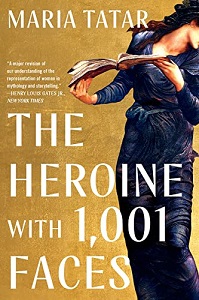Maria Tatar, The Heroine with 1,001 Faces![]()
What do women do while men leave to vanquish dragons and cross trackless seas? Is it possible for a woman to be a hero? Joseph Campbell, whose major work The Hero With a Thousand Faces popularized the ides of a “hero’s journey,” believed heroism was a singularly male pursuit (while teaching at a women’s university). In Campbell’s precepts, femininity is womb and grave, wife and temptress, a heroic man’s original source and his ultimate destination.
Maria Tatar, professor of German and children’s literature at Harvard University, sees a second track running under mythology. While men become heroes by leaving home and swashbuckling through the world, women often become heroic in how they resist. Put another way, heroism is something men find; it’s something women have thrust upon them, sometimes bodily. Tatar unpacks threads of feminine heroism from classical mythology and medieval folklore to modern Hollywood, sometimes with decidedly mixed results.
In the oldest mythology, Tatar finds women struggling to maintain an identity when men try to constantly control them. Helen of Troy finds herself passed, hot potato-like, between the hands of male heroes, her story getting lost along the way. Philomela literally loses her voice to her rapacious brother-in-law, who severs her tongue after violating her; but she reclaims her voice through embroidery. “Women’s work” becomes how she reclaims her voice and receives deferred justice.
Similar themes recur in Tatar’s telling, but importantly, when women find their voices, others take those voices away again. Arachne, the famous weaver whose skills challenge the gods, is a good example. In Ovid, the goddess Athena punishes Arachne, not because her weaving is excessively superior, but because she uses her weaving to call out the injustices of the Olympian gods. Modern mythologists reverse this, though, turning her into a moralistic warning against simple pride.
Nor are the connections to modernity incidental. Then as now, women seek the autonomy to tell their own stories, which they can frequently only achieve through subversive means. Consider how the #MeToo movement won its incremental successes despite, not because of, conventional media. Women fight a system designed to preserve the status quo of power and freedom, even when the existing system rewards the already excessively rewarded, and silences those who call injustice by name.
 |
| Maria Tatar |
Tatar especially appreciates women who bring the ancient unresolved questions into the modern world. She extensively unpacks authors like Margaret Atwood, Pat Barker, and Madeline Miller, who rewrite the classical myths from a woman’s viewpoint. In the Homeric traditions (which Joseph Campbell considered normative), women are either largely voiceless, like Penelope or Briseis, or downright villainous, like Circe. Tatar loves when women writers return to the ancient well and give silenced women their own voices.
Continuing into medieval folklore, Tatar examines the same themes as they recur—or, just as importantly, as they’re silenced. French fairy tale author Charles Perrault writes in “Bluebeard” of a woman captive to a terrible husband, who discovers the truth, and is rescued by her brothers. But when the same story reappears in the oral tradition, usually by women, as in the Brothers Grimm’s “Fitcher’s Bird,” the beleaguered bride rescues herself, because there’s nobody else.
Tatar’s explanatory skills work best in the classical and medieval myths that mostly inspire her and Campbell. Moving into the modern era—which, since the middle Twentieth Century, mostly means movies and TV—her critical skills become more synoptic and brief. Maybe she expects her audience to already be familiar with the Hollywood stories she mostly just mentions and briefly describes. But the product feels rushed; she doesn’t so much unpack Hollywood as name-check it.
That said, she does describe the thread of women’s resistance to worldly injustice. From Cassandra, who gets mocked and derided for speaking the truth, and Scheherazade, who tames the destructive monarch by telling tales, to modern mythic tales like Little Women and Wonder Woman, Tatar sees something continuous. Women through literary history have established themselves by telling their counter-narrative, keeping their stories alive against men. Women survive by preserving and by passing along their stories.
Maria Tatar is hardly the first scholar to postulate a feminine analogue to Campbell’s “hero’s journey.” This book’s Amazon page links to at least two books entitled “The Heroine’s Journey.” Tatar brings her contribution, a knowledge of classical and medieval mythology as capacious as Campbell’s own, arrayed thematically to demonstrate that women are no less heroic, just because they don’t conquer. Women, arguably, do something more heroic: they face an unjust (male) system, and survive.
Also by Maria Tatar:
Enchanted Hunters: The Power of Stories in Childhood

No comments:
Post a Comment